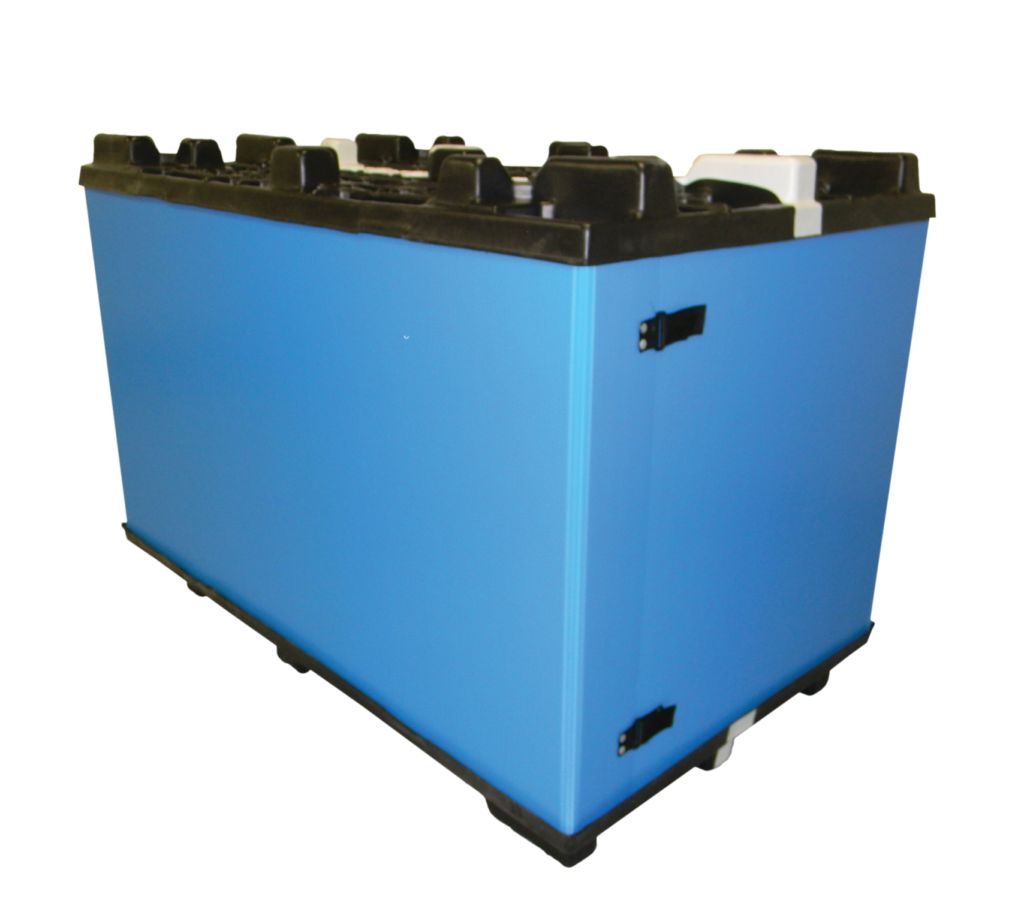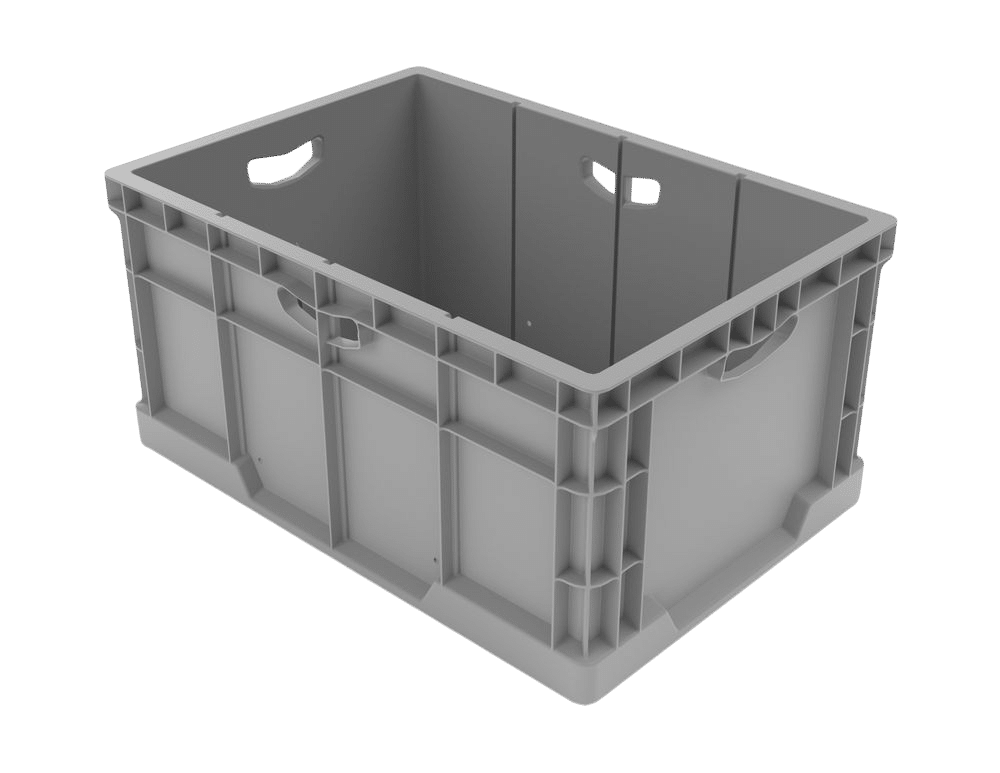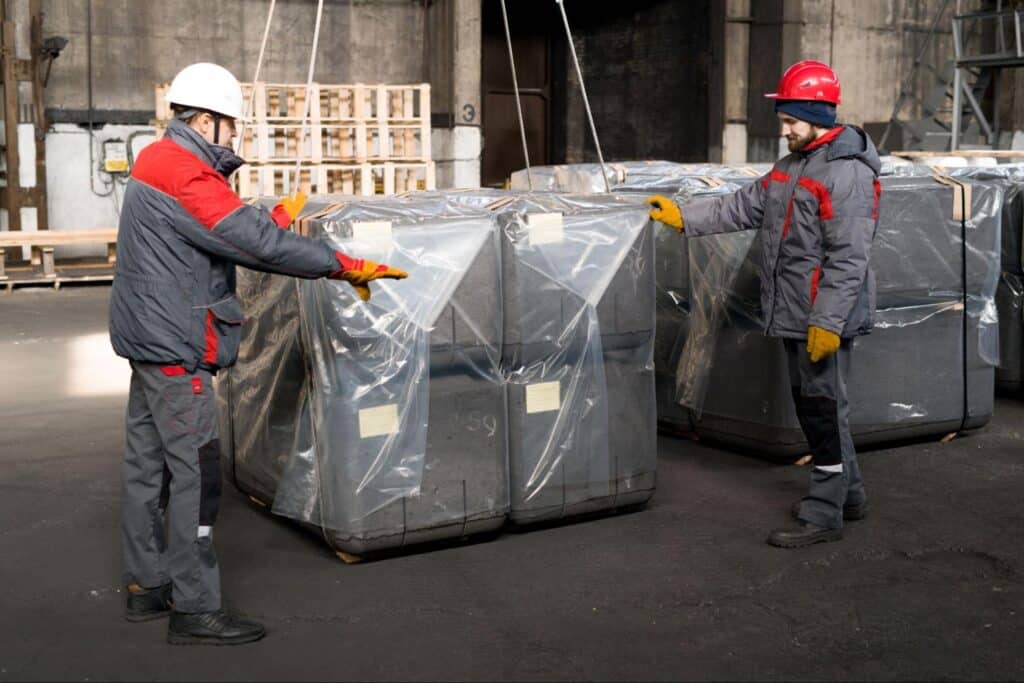The regulatory landscape for packaging is evolving rapidly — and businesses must transform their approach to stay competitive. With a heightened focus on sustainable practices, recyclability, and transparency, tertiary packaging (the outermost layer used for efficient bulk handling and logistics) is increasingly seen as a strategic asset rather than merely a legal obligation. Across major markets like the U.S., EU, and Asia, new mandates are reshaping how companies approach packaging materials, lifecycle accountability, and environmental performance.
This guide explores the key regulatory trends impacting tertiary packaging, from Extended Producer Responsibility (EPR) policies and stricter recyclability standards to enhanced labeling and transparency requirements. Whether you’re managing supply chain logistics, regulatory compliance, or sustainability initiatives, you’ll find actionable insights to help future-proof your operations. Discover how aligning your packaging practices with evolving regulations can unlock new efficiencies, reduce risk, and deliver measurable sustainability gains—while turning compliance into a competitive advantage.
Regulatory Trends in U.S. Packaging Compliance
The U.S. regulatory environment is witnessing several shifts aimed at bolstering sustainability and safety. Key focal areas include:
1. Expanded Producer Responsibility (EPR)
Companies are now held more accountable for packaging’s lifecycle. Several states – including California, Oregon, and Maine – have been among the pioneers in implementing Extended Producer Responsibility policies. These require companies to:
- Keep detailed records of packaging material use and recycling processes.
- Pay associated recycling fees.
- Integrate sustainable practices into daily operations.
2. Stricter Recyclability Standards
In many states, the emphasis is on ensuring that a significant percentage of packaging materials are made with post-consumer recycled content. For example, California’s regulatory framework under its Rigid Plastic Packaging Container (RPPC) program targets rigid plastic packaging, while broader efforts focus on materials used in rigid packaging and similar products.
3. Enhanced Safety Regulations for Sensitive Industries
Certain sectors – including medical, pharmaceutical, and military – now face additional packaging requirements. These include:
- Utilizing materials free from harmful chemicals.
- Designing packaging that safeguards products from contamination.
- Adopting specialized packaging for temperature-sensitive or hazardous shipments.
4. Improved Labeling and Transparency
Accurate and clear labeling has grown vital. New rules call for labels to indicate recyclability, provide disposal instructions and, where applicable, show compliance certifications. The goal is to reduce logistical delays and ensure smooth transitions across jurisdictions.
In summary, U.S. regulatory developments emphasize lifecycle accountability, material innovation, and transparency. By adapting proactively, companies can turn compliance into an opportunity for market differentiation.
New Regulatory Standards in EU Packaging Requirements
In the EU, sustainability is not only a regulatory mandate but also a competitive advantage. Building on its circular economy initiatives, new guidelines require:
- Adoption of low-impact materials that integrate smoothly into existing recycling systems.
- Reduction of excessive packaging layers.
Additionally, bans on materials with poor recyclability continue to broaden. Companies are encouraged to adopt unified guidelines while considering local adaptations. In this way, EU regulations drive an industry-wide shift towards environmentally responsible packaging practices, enabling organizations to meet consumer expectations while avoiding potential penalties.
Evolving Packaging Laws Across Asian Markets
Asia’s regulatory landscape is also evolving. In markets such as China, Japan, and India, current trends include:
- In China, efforts to drive a circular economy by repurposing packaging waste are well underway, supported by initiatives that promote recycling and waste reduction.
- Japan enforces strict recycling mandates under its Packaging Recycling Act, ensuring that packaging materials are processed in line with established environmental standards.
- India has taken significant steps to curtail single-use plastics and enhance packaging safety through regulatory actions, such as bans on several single-use plastic items.
While some Southeast Asian countries are beginning to explore sustainable packaging measures, detailed initiatives—such as the adoption of compostable materials or comprehensive deposit-return systems—are still evolving. Thus, although regulatory progress in key markets is robust, the overall picture in parts of Asia continues to develop.
Preparing for Packaging Compliance: Best Practices
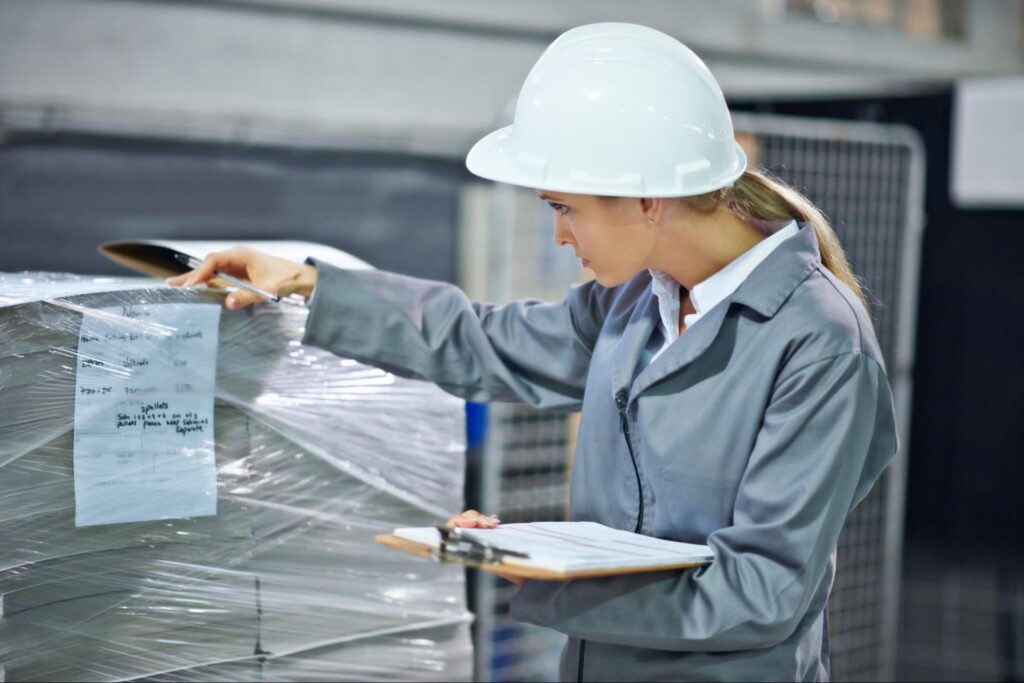
Operating across these diverse regions introduces layers of complexity, making a unified compliance strategy essential. Here are the best practices to navigate these changes.
1. Conduct Regular Compliance Audits
- Routinely evaluate your packaging materials, labeling practices, and sustainability metrics.
- Engage both internal teams and external experts to ensure ongoing alignment with current standards.
2. Prioritize Sustainable and Reusable Materials
- Transition to eco-friendly options such as reusable containers.
- Choose designs that support the circular economy and reduce waste.
3. Stay Updated on Regulatory and Market Trends
- Maintain a centralized system to monitor developments in packaging laws globally.
- Regular updates help preempt compliance issues and adapt to evolving consumer preferences.
4. Collaborate with Packaging Specialists
- Leverage expert insights in material selection and design strategies.
- Work with partners who balance sustainable practices and operational excellence, serving as one component of a broader compliance strategy.
5. Leverage Digital Tracking and Reporting
- Integrate technology solutions to monitor sourcing, recyclability, and certifications in real time.
- Streamlined digital tools enable more efficient audits and regulatory documentation.
6. Streamline Efficiency and Sustainability
- Design packaging systems that optimize logistics while meeting stringent global standards.
- Embrace multifunctional solutions – such as reusable and repairable packaging – to reduce waste and cut costs.
Your 90-Day Packaging Compliance Action Plan
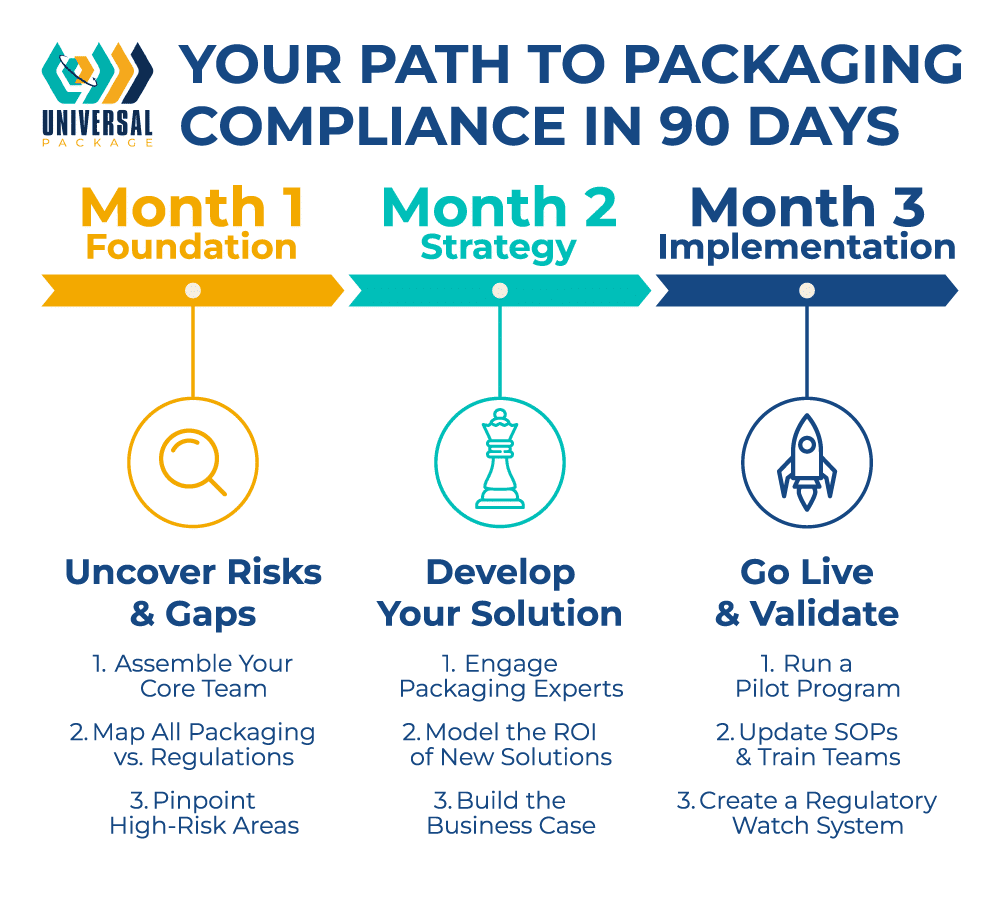
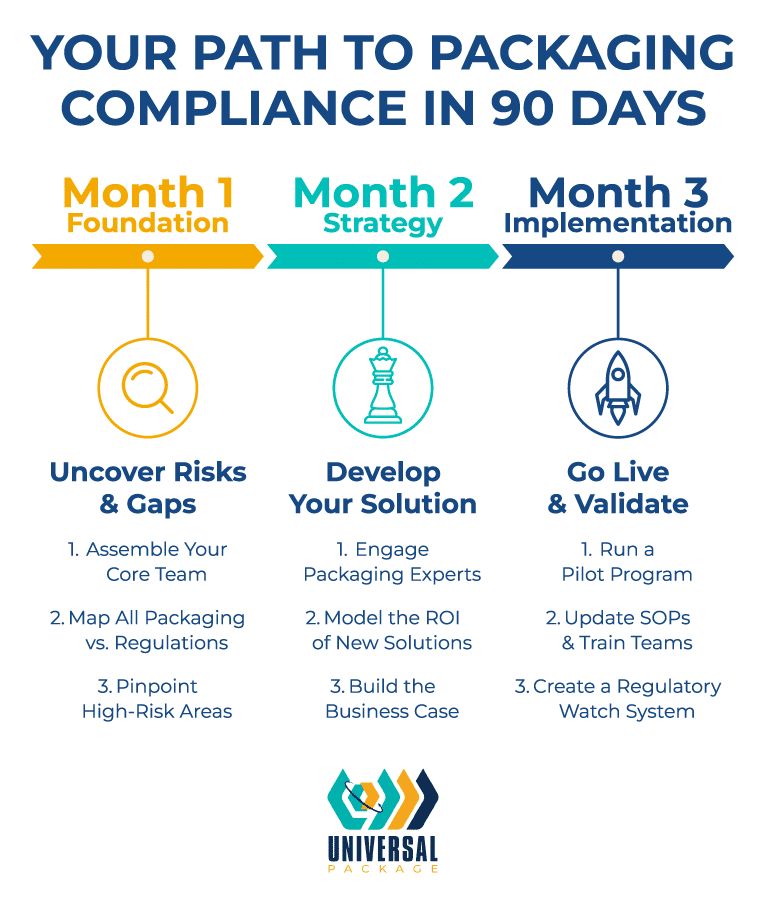
Moving from knowledge to action is the most critical step. Tackling global compliance can feel overwhelming, but a structured 90-day plan can break it down into manageable, high-impact tasks. Use this blueprint to build momentum, demonstrate progress, and create a resilient, future-proof packaging strategy.
Month 1: Audit & Assess – Build Your Foundation
The goal this month is to gain a complete and honest understanding of your current compliance posture and identify your biggest risks.
- Task 1: Form a Cross-Functional Compliance Team. Assemble key stakeholders from Procurement (to analyze costs), Logistics (to understand handling realities), and Legal/Compliance (to interpret regulations). This team will own the compliance initiative and ensure alignment across the business.
- Task 2: Conduct a Full Packaging Audit. Create a master inventory of all current tertiary packaging materials, designs, and labels. Methodically compare this inventory against the latest US (state-level EPR), EU (PPWR), and key Asian market regulations to identify every gap.
- Task 3: Identify and Prioritize High-Risk Areas. You can’t fix everything at once. Isolate the top 3-5 highest-risk areas based on revenue, market (e.g., California, Germany), or products with the most complex or problematic packaging. This is where you will focus your initial efforts.
Month 2: Strategize & Partner – Develop Your Solution
With a clear picture of your risks, the goal this month is to develop a data-driven solution and secure internal buy-in.
- Task 1: Schedule Consultations with Packaging Specialists. Leverage external expertise. Engage with packaging providers to explore compliant, reusable alternatives, custom-engineered designs, and innovative materials that can solve the specific problems you identified in your audit.
- Task 2: Get Quotes for Sustainable Transitions. Obtain detailed quotes that go beyond unit price. Analyze the long-term ROI, including projected savings from reduced material waste, lower damage rates, and the elimination of potential non-compliance fines.
- Task 3: Present the Business Case to Leadership. Using the data from your audit and the “High Stakes” framework, present a clear, compelling case to leadership. Frame the investment not as a cost, but as a critical risk mitigation strategy with a clear financial and operational upside.
Month 3: Implement & Pilot – Put the Plan into Action
The final goal is to operationalize your strategy, prove its effectiveness with a controlled pilot, and establish a system for continuous improvement.
- Task 1: Launch a Pilot Program. Select one of your high-risk product lines and implement the new, compliant packaging solution. Meticulously track its performance, measuring damage rates, shipping costs, and handling efficiency to validate your business case with real-world data.
- Task 2: Update Internal Documentation and Processes. Operationalize the change. Update your internal SOPs, material specification documents, and warehouse training protocols to reflect the new packaging standards. Ensure your labeling processes are fully aligned with the new requirements.
- Task 3: Establish a System for Ongoing Regulatory Monitoring. Compliance is not a one-time project. Assign responsibility within your team for monitoring regulatory updates from key markets. Schedule quarterly check-ins with your compliance team to ensure your strategy remains current and proactive.
Emerging Innovations in Sustainable Packaging Technology
Innovative technologies, including advanced digital tracking systems, are increasingly helping companies address packaging compliance challenges. Organizations are deploying IoT sensors and real-time analytics to monitor many lifecycle stages of packaging materials—from production and distribution to end-of-life processing. While these systems offer significant insights and enhanced visibility, ensuring complete documentation and transparency across every step—particularly during the recycling phase—remains an ongoing challenge.
Machine learning algorithms also assist in optimizing packaging designs to reduce material usage without compromising strength or product protection. Combined with automated imaging and sorting in recycling facilities, these technologies help facilitate compliance with complex regulatory standards while also reducing operational costs. By integrating technology into packaging processes, companies can drive both higher sustainability and improved efficiency.
How Universal Package Drives Compliance and Innovation

Navigating the complexities of global packaging regulations requires a partner with deep expertise in materials, design, and logistics. Universal Package is dedicated to delivering high-quality, customizable packaging solutions that emphasize sustainability and efficiency, helping clients in demanding sectors—including automotive, medical, electronics, and pharmaceuticals—meet and exceed rigorous compliance standards.
Our expertise is evident in the tangible solutions we provide. Instead of one-size-fits-all approaches, we engineer specific tertiary packaging solutions that solve modern compliance challenges, including:
- Custom-built crates designed to protect high-value industrial parts while optimizing shipping space.
- Durable, reusable pallets that form the backbone of a circular supply chain, reducing waste and long-term costs.
- Efficient sleeve packs that minimize material usage without compromising the integrity of grouped products.
At Universal Package, we engineer packaging that’s optimized for your industry-specific needs. Our compliance expertise ensures that our solutions meet and exceed regulatory requirements. Our long-standing commitment to quality makes us a valued partner in achieving both operational and environmental objectives.
Embracing Compliance: The Path Forward
Global packaging regulations continue to reshape the way businesses manage packaging processes. With a heightened emphasis on sustainability, recyclability, and transparency, companies must reimagine the role of tertiary packaging amid evolving regulatory and consumer demands. Strategic initiatives—such as auditing packaging materials, collaborating with knowledgeable industry specialists, and embracing eco-friendly designs—are critical to turning compliance challenges into competitive advantages.
Transform your packaging approach and discover how innovative, sustainable practices fueled by smart technologies can drive a resilient and profitable future. To learn more about customized packaging solutions tailored to your compliance needs, contact Universal Package for a consultation on products and services that can help you stay aligned with packaging compliance.


